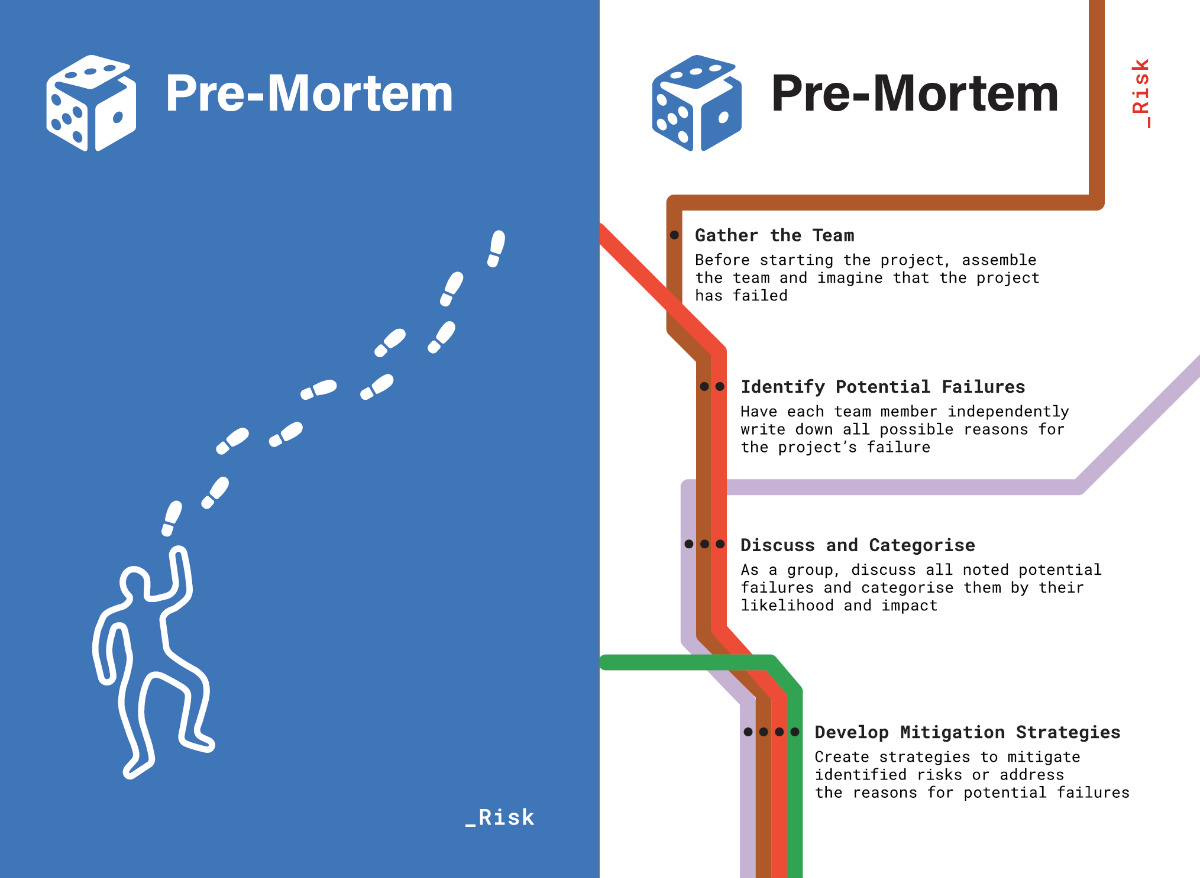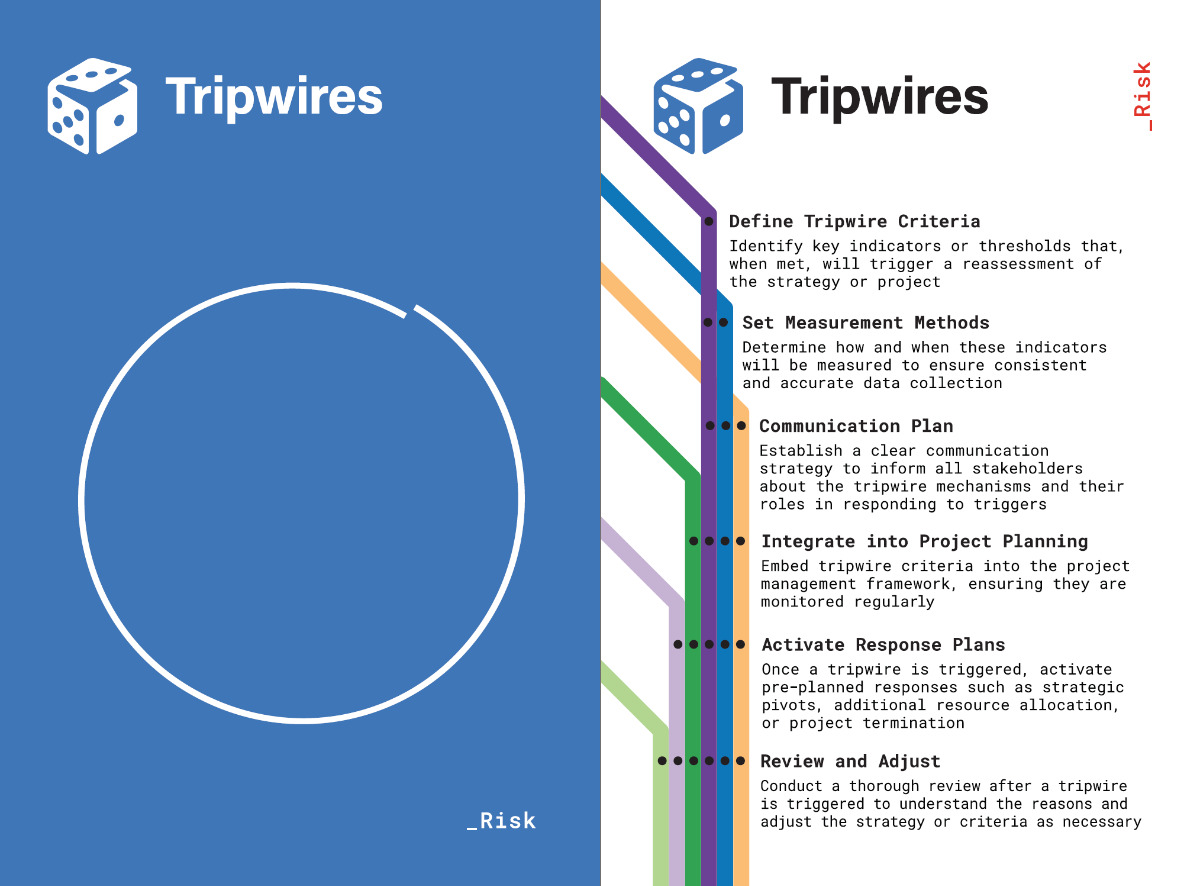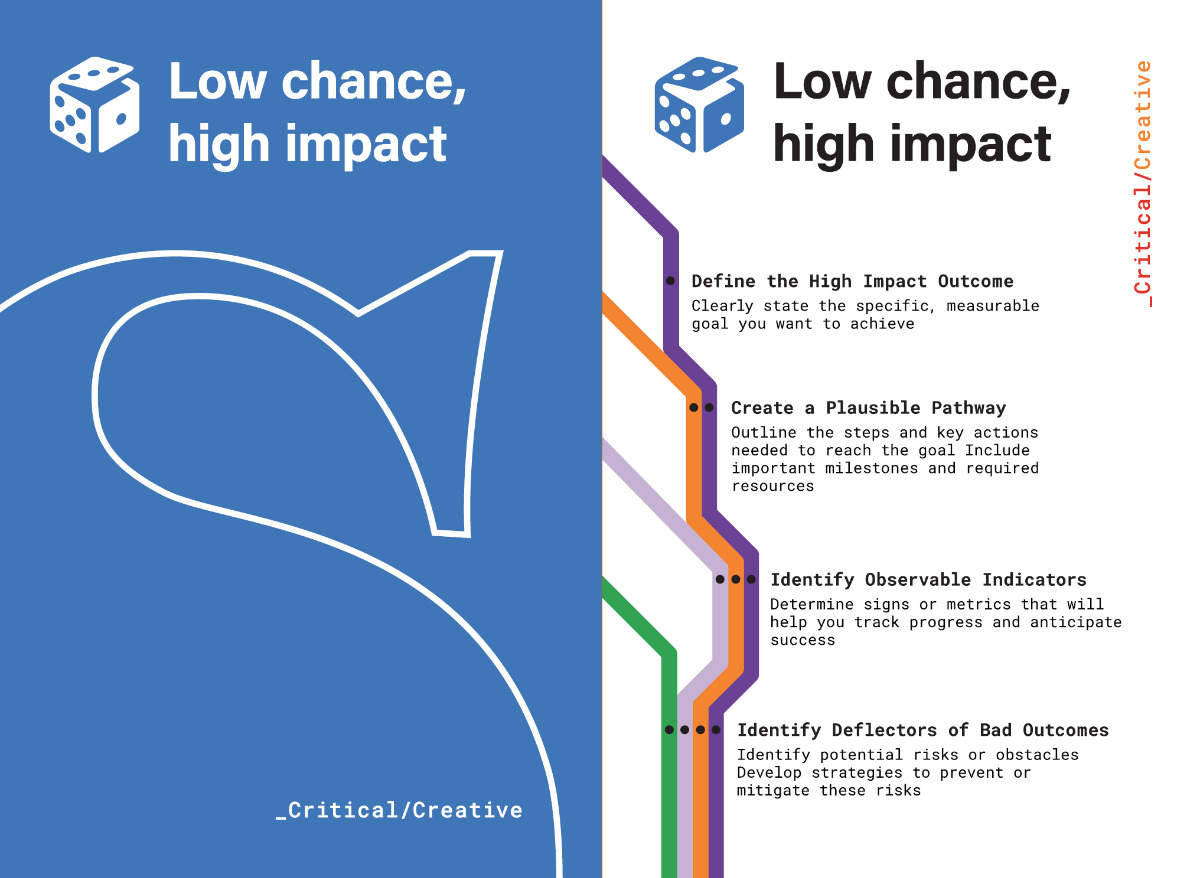Strategic Thinking Exercise Series - week 5
Jul 21, 2025 9:24 pm
This is part 5 of our 9-part tabletop exercise series. Please read from part 1 chronologically and enjoy each week as we spotlight three exercises from our new PRISM Strategic Tabletop Exercise Guide Deck—27 decision-making tools that teams can run in real-time, in real rooms, on real challenges.
Strategic Thinking Exercise Series - Week 5: Risk Anticipation
Remember Week 2's Cynefin diagnosis? Simple domains have predictable risks that best practices handle. Complicated domains have technical risks that expert analysis identifies. Complex domains have emergent risks that only systematic probing reveals. Chaotic domains have catastrophic risks requiring immediate response capability. Implementation succeeds when risk anticipation matches domain complexity.
Risk Anticipation
This week introduces three systematic risk exercises in deliberate sequence—Pre-Mortem → Tripwires → Low Chance-High Impact—that transform implementation confidence into resilience by systematically anticipating failure modes, establishing early warning systems, and preparing for unlikely but catastrophic scenarios.
Why this specific progression: Failure anticipation first (identify what could go wrong), early warning second (detect problems before they become crises), catastrophic preparation third (prepare for unlikely but devastating scenarios). Each exercise addresses different temporal and probability aspects of implementation risk.
The meta: Hope is not a strategy; preparation is. Optimistic implementation planning creates expensive surprises. Systematic risk anticipation creates resilient execution that adapts to challenges without abandoning strategic direction. This sequence provides implementation insurance while maintaining strategic momentum.
🎲 Pre-Mortem – Time Travel
What: Reverse engineering methodology that begins with imagined project failure and works backward to identify potential causes, enabling proactive risk mitigation before implementation begins.
Why: Traditional risk analysis asks, "What could go wrong?" which triggers defensive thinking and incomplete assessment. Pre-Mortem asks "Given that this failed, why did it fail?" which accesses fuller pattern recognition and reduces optimism bias that impairs realistic risk assessment.
When: Before major implementation begins, during strategic planning, at project initiation, any situation with significant resource commitment or organisational impact requiring systematic risk anticipation.
The Steps
Phase 1: Gather the Team Assemble everyone involved in strategy execution before implementation begins. Include diverse perspectives: technical implementers, business stakeholders, external partners, sceptical voices. Timing is critical—conduct a Pre-Mortem after strategy selection, but before resource commitment creates sunk cost bias.
Phase 2: Imagine Complete Failure Establish shared scenario: "It's 18 months from now. Our strategy has failed completely. Implementation stopped, resources were wasted, organisational confidence damaged." Make failure vivid and specific to your context—market expansion collapsed, digital transformation abandoned, partnership dissolved.
Phase 3: Independent Failure Cause Generation Each team member individually writes down all possible reasons for project failure. Emphasise quantity over quality—capture everything from obvious risks to unlikely scenarios. Use structured prompts: technical failures, market changes, organisational resistance, resource constraints, competitive responses, external shocks.
Phase 4: Systematic Categorisation and Mitigation Collectively discuss all identified failure modes without criticism or defensiveness. Categorise risks by likelihood and impact using a 2x2 matrix. Develop specific mitigation strategies for high-probability and high-impact risks. Document everything for ongoing risk monitoring.
Professional Facilitation Methodology
Scenario authenticity: Make failure scenario specific and emotionally realistic. "The project failed" is too abstract. "The CEO announced suspension of the initiative at the all-hands meeting, citing disappointing results and resource reallocation to core business" creates a psychological reality that improves failure mode identification.
Individual generation discipline: Enforce silent individual brainstorming before group discussion. Social conformity and optimism bias contaminate group failure identification. Individual generation first captures a fuller risk spectrum before group dynamics narrow thinking.
Non-defensive discussion culture: Establish explicit norms that failure mode identification isn't a criticism of strategy quality. Frame as "insurance thinking"—we buy fire insurance not because we expect fires but because we prepare for possibilities. Risk identification strengthens rather than undermines implementation confidence.
Mitigation specificity: Avoid generic risk responses like "monitor closely" or "communicate frequently." Develop specific actions: "Weekly customer interviews to detect adoption issues," "Monthly competitive analysis to identify response patterns," "Quarterly budget reviews with predefined trigger points for resource reallocation."
Example Applications
Enterprise digital transformation Pre-Mortem:
Failure scenario: "Digital transformation initiative cancelled after 14 months, $8M invested, minimal business impact achieved."
Identified failure modes:
- Technical: Legacy system integration failures, security vulnerabilities, performance issues
- Organisational: Employee resistance, skill gaps, change management inadequacy
- Business: ROI not materialising, customer disruption, competitive responses
- External: Regulatory changes, vendor problems, economic downturn
Categorisation insights: Employee resistance is rated high probability/high impact. Vendor problems are rated low probability/high impact. ROI timing rated medium probability/medium impact.
Mitigation strategies developed:
- Employee resistance: Early involvement in design, transparent communication, incentive alignment
- Vendor problems: Multiple vendor strategies, contract terms with performance guarantees
- ROI timing: Phased implementation with value demonstration at each stage
Market expansion Pre-Mortem:
Failure scenario: "European expansion terminated after 18 months, market entry unsuccessful, partnership relationships damaged."
Identified failure modes:
- Market: Demand assumptions incorrect, competitive response stronger than expected, regulatory barriers
- Operational: Local hiring difficulties, cultural misunderstandings, logistics complications
- Financial: Currency volatility, higher-than-expected costs, cash flow pressures
- Strategic: Brand positioning confusion, product-market fit gaps, partnership conflicts
Risk patterns: Cultural and regulatory risks are underestimated in initial planning. Financial risks are concentrated around currency and cost estimation. Partnership risks emerged from cultural misunderstanding themes.
Proactive mitigation:
- Cultural risks: Local advisory board, cultural integration training, partnership protocols
- Regulatory risks: Legal consultation before market entry, phased approach with early compliance validation
- Financial risks: Currency hedging strategy, contingency budgets, milestone-based investment
Common Failure Modes
Systematic blind spots: Teams consistently underestimate specific risk categories. Technical teams minimise organisational resistance. Business teams underestimate technical complexity. External teams miss internal political dynamics. Use diverse perspectives to identify systematic blind spots.
Optimism correction: Compare Pre-Mortem identified risks with similar project post-mortems from organisational history. This calibrates risk assessment against actual historical patterns rather than hopeful projections.
Failure mode clustering: Related risks often compound each other. Employee resistance + technical difficulties = implementation crisis. Market changes + competitive response = strategic obsolescence. Identify risk clusters that could create cascading failures.
Implementation
Risk ownership assignment: Every identified risk needs specific ownership and monitoring responsibility. Avoid diffuse accountability ("the team will monitor") in favour of particular tasks ("Sarah monitors competitive response monthly, reports at the steering committee").
Mitigation resource allocation: Include risk mitigation costs in implementation budgets. Teams often identify risks but don't allocate resources for prevention, making mitigation plans theoretical rather than actionable.
Success criteria adjustment: Use Pre-Mortem insights to refine success metrics and timelines. If failure analysis reveals implementation complexity, adjust expectations accordingly rather than maintaining optimistic projections that create false failure perception.
🎲 Tripwires – Alarm System
What: Systematic indicator identification and monitoring framework that establishes measurable thresholds triggering strategy reassessment before small problems become large failures.
Why: Most implementation failures provide early warning signals that teams miss or ignore. Tripwires create disciplined attention to weak signals and predetermined response protocols that prevent reactive crisis management when strategic adjustment is still possible.
When: Following Pre-Mortem analysis to monitor identified risks, during implementation planning, for ongoing strategic monitoring, any situation requiring early detection of implementation drift or environmental change.
The Steps
Step 1: Define Tripwire Criteria Identify specific, measurable indicators that signal potential implementation problems or environmental changes requiring strategic reassessment. Connect directly to Pre-Mortem failure modes and Week 4 evaluation assumptions. Focus on leading indicators that predict problems rather than lagging indicators that confirm failures.
Step 2: Set Measurement Methods Determine how and when indicators will be measured to ensure consistent and accurate data collection. Specify data sources, collection frequency, responsibility assignments, and measurement protocols that maintain signal quality over time.
Step 3: Establish Threshold Triggers Define specific numeric thresholds that automatically trigger reassessment processes. Avoid subjective triggers ("things seem concerning") in favour of objective criteria ("customer acquisition cost exceeds $500" or "employee satisfaction drops below 7.2").
Step 4: Design Communication Protocols Create clear communication strategy informing all stakeholders about tripwire mechanisms and response responsibilities. Include escalation procedures, decision authority, and timeline expectations for addressing triggered tripwires.
Step 5: Integrate Into Project Management Embed tripwire monitoring into the regular project management framework rather than treating it as a separate activity. Include tripwire status in standard reporting, resource allocation for monitoring activities, and systematic review processes.
Step 6: Develop Response Plans Create predetermined responses for triggered tripwires: strategic pivots, additional resource allocation, implementation timeline adjustment, or project termination. Having responses planned in advance prevents reactive decision-making under pressure.
Facilitation
Leading indicator identification: Focus on predictive rather than confirmatory measures. "Customer complaint volume increasing" predicts retention problems. "Customer churn rate rising" confirms that retention problems have already occurred. Leading indicators enable a proactive response; lagging indicators enable only a reactive response.
Threshold calibration: Set tripwire thresholds that balance sensitivity with false alarm rates. Being too sensitive creates alert fatigue and response exhaustion. Too insensitive to miss important early warnings. Use historical data and expert judgment to calibrate meaningful but manageable thresholds.
Responsibility specificity: Assign tripwire monitoring to specific individuals with clear accountability and sufficient authority to trigger responses. Diffuse responsibility ("the team monitors") leads to responsibility diffusion and ignored signals.
Response planning discipline: Develop specific response protocols before tripwires trigger. Emergency decision-making under pressure produces reactive rather than strategic responses. Pre-planned responses maintain strategic discipline during implementation stress.
Example Applications
SaaS product launch tripwire system
Key indicators monitored:
- Customer acquisition: Daily signup rates, cost per acquisition, conversion funnel performance
- Product adoption: Feature usage rates, user engagement time, support ticket volume
- Technical performance: System uptime, response times, error rates
- Market response: Competitive pricing changes, alternative solution launches, analyst coverage
Specific tripwires established:
- Customer acquisition cost exceeds $200 → reassess marketing strategy
- Weekly churn rate above 5% for three consecutive weeks → investigate product-market fit
- System downtime exceeds 99.5% availability → technical architecture review
- Competitor launches similar feature → competitive response protocol activation
Response protocols:
- Marketing reassessment: 48-hour strategy review, budget reallocation options, channel optimisation
- Product-market fit investigation: Customer interview campaign, feature usage analysis, positioning review
- Technical review: Infrastructure scaling plan, vendor escalation, backup system activation
- Competitive response: Feature acceleration, pricing strategy review, partnership exploration
International expansion tripwire framework
Environmental monitoring:
- Regulatory: Policy change announcements, compliance requirement shifts, legal precedent changes
- Economic: Currency volatility, market growth rates, inflation indicators
- Competitive: New market entrants, pricing changes, partnership announcements
- Operational: Local talent availability, supply chain stability, customer feedback patterns
Critical thresholds:
- Currency fluctuation exceeds ±15% → financial hedging strategy review
- Market growth rate falls below 5% annually → opportunity reassessment
- Local hiring success rate below 60% → talent strategy modification
- Customer satisfaction scores under 7.0 → cultural adaptation review
Predetermined responses:
- Financial strategy: Currency hedging instruments, pricing adjustments, cost structure modifications
- Market opportunity: Investment level adjustment, timeline modification, exit consideration
- Talent strategy: Partnership with local firms, compensation adjustment, remote work options
- Cultural adaptation: Local advisory engagement, product modification, marketing approach revision
Tripwire Design Principles
Cascade prevention: Design tripwires that detect problems before they cascade into multiple domains. Employee satisfaction decline predicts productivity problems, customer service issues, and talent retention challenges. Early intervention prevents single problems from becoming systemic crises.
Signal aggregation: Combine multiple weak signals into stronger early warning systems. Individual metrics might not trigger concern, but patterns across multiple indicators reveal emerging problems requiring attention.
Environmental scanning: Include external environmental indicators alongside internal performance metrics. Market changes, competitive shifts, and regulatory developments often provide earlier warning than internal performance data.
System Integration and Maintenance
Tripwire evolution: Regularly review and adjust tripwire criteria based on implementation learning and environmental changes. Static tripwires become obsolete as strategies evolve and conditions change.
False alarm management: Track false alarm rates and adjust thresholds to maintain signal quality. Too many false alarms create alert fatigue and reduced response effectiveness.
Response capability: Ensure organisational capability to execute predetermined responses when tripwires trigger. Response plans require resources, authority, and skills that must be available.
🎲 Low Chance, High Impact – Black Swan lens
What: Systematic identification and preparation methodology for unlikely but potentially catastrophic scenarios that could destroy otherwise sound strategies, focusing on deflection strategies and rapid response capability.
Why: Traditional risk management focuses on probable scenarios while ignoring low-probability, high-impact events that cause disproportionate strategic damage. Black swan preparation creates resilience against unlikely but devastating scenarios that conventional planning misses.
When: Following tripwire design for comprehensive risk coverage, strategic planning for critical initiatives, crisis preparation, any situation where catastrophic scenarios could threaten organisational survival or strategic viability.
The Steps
Step 1: Define High Impact Outcomes Clearly state specific, measurable catastrophic scenarios that would destroy strategic value or threaten organisational survival. Focus on outcomes rather than causes—"lose 50% of customer base within 6 months" rather than "data breach occurs." Make scenarios concrete enough for preparation planning.
Step 2: Create Plausible Pathways Develop realistic scenarios explaining how catastrophic outcomes could emerge from current conditions. Include triggering events, escalation patterns, stakeholder responses, and system dynamics that could produce catastrophic results from initially manageable problems.
Step 3: Identify Observable Early Indicators Determine weak signals or leading indicators that might provide advance warning of catastrophic scenario development. Focus on indicators that appear before escalation becomes irreversible, enabling intervention while response options still exist.
Step 4: Design Deflection and Response Strategies Develop specific strategies to prevent catastrophic scenarios and rapid response capabilities for scenarios that cannot be prevented. Emphasise deflection (preventing catastrophe) over recovery (responding after catastrophe) while maintaining response capability for unpreventable scenarios.
Facilitation
Scenario realism calibration: Balance scenario severity with plausibility to maintain strategic relevance. "Nuclear war destroys civilisation" is catastrophic but not strategically actionable. "Key regulatory approval gets reversed" is both catastrophic and actionable for pharmaceutical companies.
Pathway development discipline: Create detailed causal chains from triggering events to catastrophic outcomes. Vague scenarios ("everything goes wrong") don't enable preparation. Specific pathways ("product recall leads to regulatory investigation leads to market access loss leads to revenue collapse") enable systematic intervention point identification.
Indicator sophistication: Identify early warning signals that precede common knowledge. Public indicators (newspaper headlines, stock price movements) provide late warning when response options are limited. Private indicators (employee concerns, customer complaints, supplier signals) enable earlier intervention.
Deflection vs. response balance: Prioritise preventing catastrophes over recovering from them. Prevention is always more effective and less expensive than response. But maintain response capability for scenarios that cannot be prevented through reasonable preparation.
Example Applications
Technology company platform catastrophe preparation
High impact outcome: "Platform security breach compromises 10M+ customer records, resulting in regulatory penalties, customer exodus, and brand reputation destruction."
Plausible pathway: Zero-day vulnerability discovered → exploit development by sophisticated attackers → breach of customer database → data exfiltration → public disclosure → regulatory investigation → customer trust collapse → competitive advantage loss → revenue decline → potential organisational survival threat.
Observable indicators:
- Technical: Unusual network traffic patterns, failed authentication attempts, security tool alerts
- Intelligence: Dark web mentions, hacker forum discussions, vulnerability research publications
- Environmental: Regulatory scrutiny increases, competitor breaches, industry security incidents
Deflection strategies:
- Technical: Multi-layer security architecture, regular penetration testing, bug bounty programs
- Process: Security-first development culture, mandatory security training, incident response protocols
- Strategic: Cyber insurance coverage, legal compliance systems, customer communication frameworks
Response capabilities:
- Immediate: Incident containment, customer notification, regulatory reporting
- Short-term: Forensic investigation, security enhancement, customer retention programs
- Long-term: Brand rebuilding, competitive repositioning, organisational learning integration
Global supply chain catastrophe planning
High impact outcome: "Critical supplier network collapses, creating 6-month production halt, customer contract breaches, and market share loss to competitors with resilient supply chains."
Plausible pathway: Natural disaster affects key supplier region → infrastructure damage prevents production → alternative suppliers lack capacity → inventory depletion → production stops → customer delivery failures → contract penalties → customer relationships damaged → competitors gain market share → revenue collapse threatens strategic position.
Observable indicators:
- Environmental: Weather pattern monitoring, geopolitical tension indicators, infrastructure vulnerability assessments
- Supplier: Financial health monitoring, capacity utilisation rates, geographical concentration analysis
- Market: Alternative supplier capacity, competitor supply chain strategies, customer contract terms
Deflection strategies:
- Diversification: Multi-supplier strategy, geographical distribution, capacity redundancy
- Relationship: Supplier financial monitoring, partnership strengthening, exclusive arrangements
- Operational: Strategic inventory, flexible manufacturing, customer contract modifications
Response capabilities:
- Crisis: Alternative sourcing activation, customer communication, production ramp-up protocols
- Recovery: Supplier relationship rebuilding, capacity expansion, customer retention programs
- Strategic: Supply chain redesign, competitive advantage rebuilding, organisational resilience enhancement
Black Swan Pattern Recognition
System fragility identification Look for single points of failure that could cascade into catastrophic outcomes. Concentrated supplier dependencies, key person risks, and critical technology dependencies that create systemic vulnerability requiring diversification or redundancy.
Escalation dynamics: Understand how small problems amplify into large catastrophes through feedback loops, stakeholder responses, and system dynamics. Customer complaints become social media campaigns, become regulatory attention, and become a competitive disadvantage.
Recovery vs. deflection economics: Calculate the cost of deflection strategies versus potential catastrophic losses. Spending 2% of revenue on supply chain diversification might prevent 50% revenue loss from collapse. Most deflection strategies provide positive expected value even for low-probability scenarios.
Implementation Integration and Maintenance
Scenario updating Regularly review catastrophic scenarios as business models, technologies, and environments evolve. New dependencies create new vulnerabilities requiring updated preparation strategies.
Deflection maintenance Ensure deflection strategies remain current and effective. Security systems require updates, supplier relationships need maintenance, and response plans need testing and refinement.
Organisational learning Integrate insights from near-miss incidents and other organisations' catastrophic experiences. What almost went wrong? What did similar organisations experience? How could those lessons improve preparation?
Before and After
Before state Implementation confidence without systematic risk preparation, reactive crisis management, preventable failures causing strategic derailment, surprised organisations wondering "how did we miss this?"
After state Systematic failure anticipation (Pre-Mortem identification), early warning systems (Tripwire monitoring), catastrophic preparation (Black Swan deflection), implementation resilience that adapts to challenges without abandoning strategic direction.
The compound effect: These three exercises provide comprehensive risk coverage across probability and time horizons. Pre-Mortem identifies likely implementation challenges. Tripwires detect emerging problems. Black Swan preparation handles unlikely but devastating scenarios.
Measurable Risk Readiness Indicators
Risk identification completeness Percentage of actual implementation challenges that were identified in advance (target: 80%+ for major risks, 60%+ for minor risks).
Early warning effectiveness Time between tripwire trigger and problem escalation (target: 2-4 weeks advance warning for strategic issues).
Response readiness Time from problem identification to response implementation (target: 24-48 hours for predetermined responses).
Risk Management Failure Mode Prevention
Optimism bias persistence Conducting risk exercises but mentally discounting identified risks as unlikely or manageable. Prevention: Treat risk identification as insurance rather than pessimism—prepare for possibilities regardless of preferences.
Monitoring system degradation Establishing tripwires but allowing monitoring discipline to decay over time. Prevention: Integrate monitoring into standard processes and regularly review signal quality and response readiness.
Black swan complacency Focusing only on probable risks while ignoring catastrophic scenarios. Prevention: Allocate specific resources to catastrophic preparation regardless of probability estimates.
Your Week 5 Implementation Challenge
Apply this risk anticipation sequence to the strategy you selected through Week 4's systematic evaluation. Use your Week 2 domain diagnosis to calibrate risk intensity—Complex domains need more comprehensive risk preparation than Simple domains.
Execution Protocol
Session structure 180 minutes total
- Pre-Mortem: 75 minutes (15 scenario setup, 20 individual failure generation, 25 group categorisation, 15 mitigation planning)
- Tripwires: 60 minutes (20 indicator identification, 15 threshold setting, 15 monitoring design, 10 response planning)
- Low Chance-High Impact: 45 minutes (15 catastrophic scenario development, 15 pathway analysis, 15 deflection strategy design)
Success Criteria Checklist
Pre-Mortem completion
[ ] Identified 15+ potential failure modes across technical, organisational, market, and external categories
[ ] Categorised risks by likelihood and impact with team consensus
[ ] Developed specific mitigation strategies for high-probability and high-impact risks
[ ] Assigned risk ownership and monitoring responsibility to specific individuals
[ ] Integrated risk mitigation costs into implementation budgets and timelines
Tripwire system design
[ ] Identified 8-12 leading indicators that predict implementation problems
[ ] Established specific numeric thresholds that trigger automatic reassessment
[ ] Designed monitoring protocols with data sources, frequency, and responsibility assignments
[ ] Created communication procedures for tripwire activation and escalation
[ ] Developed predetermined response plans for each tripwire category
Black Swan preparation
[ ] Defined 3-5 catastrophic scenarios that could destroy strategic value
[ ] Developed plausible pathways from current conditions to catastrophic outcomes
[ ] Identified early warning indicators that precede catastrophic escalation
[ ] Designed deflection strategies that prevent catastrophes and response capabilities for unpreventable scenarios
[ ] Allocated resources for catastrophic preparation regardless of probability estimates
Diagnostic Signals and Responses
Positive indicators
- Risk comprehensiveness Identified risks span multiple categories and time horizons, indicating systematic rather than narrow risk thinking.
- Response readiness: Predetermined responses include specific actions, resource requirements, and responsibility assignments rather than generic intentions.
- Integration quality Risk preparation connects seamlessly to implementation planning rather than existing as separate theoretical exercise.
Common Failure Modes
- Optimism persistence: If identified risks seem manageable and unlikely, challenge scenario realism and risk assessment discipline.
- Monitoring complexity: If tripwire systems require significant ongoing resources, simplify indicators while maintaining signal quality.
- Catastrophic avoidance: If teams resist developing black swan scenarios, emphasise preparation value over probability accuracy.
Domain-Specific Risk Calibration
Simple domain approach Focus on operational risks and best practice compliance. Minimal catastrophic preparation is needed. Emphasise execution discipline over risk complexity.
Complicated domain approach: Balance technical and organisational risks—Emphasise expert input for technical risk assessment—moderate catastrophic preparation for technical failures.
Complex domain approach: Comprehensive risk preparation across all categories. Emphasise emergent and system risks—significant catastrophic preparation for unforeseen developments.
Chaotic domain approach: Focus on rapid response capabilities over prediction. Extensive catastrophic preparation for multiple crisis scenarios. Maintain maximum implementation flexibility.
The Strategic Bridge to Assumption Challenge
Risk anticipation is complete. Implementation resilience established. Failure modes identified and mitigated. Early warning systems monitor progress. Catastrophic scenarios are prepared with deflection strategies. Now you need a systematic assumption challenge to ensure your carefully prepared implementation rests on solid strategic foundations.
Progression: Week 1 taught rapid decision-making. Week 2 taught precision framing. Week 3 taught option generation. Week 4 taught systematic evaluation. Week 5 taught risk anticipation. Week 6 will teach assumption validation—the hidden foundation that determines whether all previous work produces breakthrough results or expensive failures.
The preparation-to-foundation bridge Risk anticipation prepares you for implementation challenges, but assumption validation determines whether you're implementing the right strategy based on valid strategic premises.
Next focus: From risk anticipation to assumption challenge—three exercises that stress-test the strategic foundations underlying your carefully prepared implementation by systematically identifying and validating core assumptions before they can cause strategic misdirection. Key Assumptions Check (assumption identification and testing), Competing Hypothesis (alternative explanation development), and Devil's Advocate (systematic assumption attack).
Because you can anticipate every implementation risk perfectly and fail strategically if your fundamental assumptions about reality are wrong, the most dangerous assumptions are the ones everyone agrees on without testing.
Ready to master systematic strategic thinking? Get the complete PRISM Strategic Tabletop Exercise Guide with all 27 exercises, facilitation guides, and advanced techniques. Transform your team's decision-making in real-time, in real rooms, on real challenges.
Get the full stack PRISM Tabletop Exercise set here for AUD 40, and unlock all 27 exercises.




